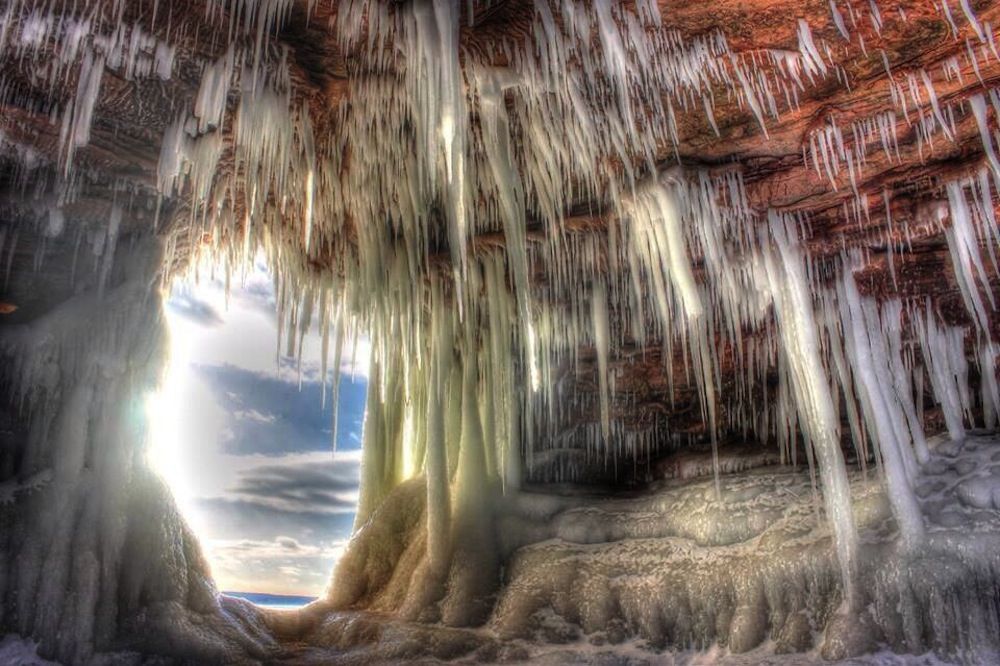
It may be time to break out the mittens, the sturdy boots and a fancy camera: A series of gorgeous ice caves could finally be open to the public this weekend.
During the winter, sea caves nestled along the shoreline at Wisconsin's remote Apostle Islands National Lakeshore turn into icy wonderlands, with several-story-tall icicles, frozen waterfalls and honeycombed walkways.
The chain of 22 islands that make up the Apostle Islands boast some of the most finely wrought sea caves, full of delicate archways and vaulted chambers that have been worked away into the cliffsides of the islands. Normally, hundreds of kayakers a day visit the ethereal caves. But during the winter months, the surface of Lake Superior freezes over and sea caves on the islands become inaccessible.
However, there are caves along the shoreline that can be accessed — provided the frozen surface of Lake Superior is stable enough to support troops of visitors trekking across it. In order for visitors to come, a solid 10-inch-thick (25.4 centimeter) layer of ice (with no slush or water in between) needs to extend for several miles out from the shoreline in multiple directions. In addition, the ice has to be stable, and have been in place for at least two weeks, said Neil Howk, the assistant chief of interpretations at Apostle Islands National Lakeshore. [Winter Wonderland: See Images of Stunning Apostle Islands Ice Caves]
"We've seen multiple times that when we have a large wind event the ice shelf can break up and blow away in a matter of hours. It's already happened twice this year," Howk told Live Science.
Until today (Feb. 24), conditions looked very promising: About 95 percent of the Great Lake was frozen over, and the ice was very thick. But a strong wind has been scouring the frozen lake's surface all afternoon, and now only about 80 percent of the lake is icebound, Howk said.
"If the ice blows away this week, we won't have an ice cave season this year," Howk told Live Science.
Sign up for the Live Science daily newsletter now
Get the world’s most fascinating discoveries delivered straight to your inbox.
Because of the difficulty of getting those conditions, the ice caves are often closed all winter. Last year, thousands of visitors flocked to the site, trekking several miles along the road before hiking a few miles along a frozen beach and the frozen surface of the lake to view the frozen formations.
But there's still hope for winter lovers everywhere: The forecast has the wind dying down tonight, and the next few days should be extra cold. If the ice shelf around the shoreline caves survives, that should stabilize the area, Howk said.
This year, the wind has blown what little snow is there off the ice, so the ice will be very slippery and rough in spots. The NPS provides current information on the ice conditions via the agency's Ice Line, which can be reached at (715) 779-3397 extension 3.
If the Apostle Islands caves open, those who visit should dress warmly, bring ski poles to walk, and sturdy shoes with traction devices such as Yaktrax or Stabiicers on them, Howk said.
Follow Tia Ghose on Twitter and Google+. Follow LiveScience @livescience, Facebook & Google+. Originally published on Live Science.

Tia is the managing editor and was previously a senior writer for Live Science. Her work has appeared in Scientific American, Wired.com and other outlets. She holds a master's degree in bioengineering from the University of Washington, a graduate certificate in science writing from UC Santa Cruz and a bachelor's degree in mechanical engineering from the University of Texas at Austin. Tia was part of a team at the Milwaukee Journal Sentinel that published the Empty Cradles series on preterm births, which won multiple awards, including the 2012 Casey Medal for Meritorious Journalism.










